Are you ready to embark on a journey through the enchanting world of animals that bear an uncanny resemblance to deer? From the majestic Pronghorn to the elusive Mouse Deer, we’ve rounded up 18 beautiful creatures that will make you do a double-take. Get ready to be amazed by their grace, mesmerized by their elegance, and perhaps even question whether they’re distant relatives of Bambi. So, grab your binoculars and let’s dive into this wild adventure of 18 animals that look like deer.
1. Pronghorn (Antilocapridae)
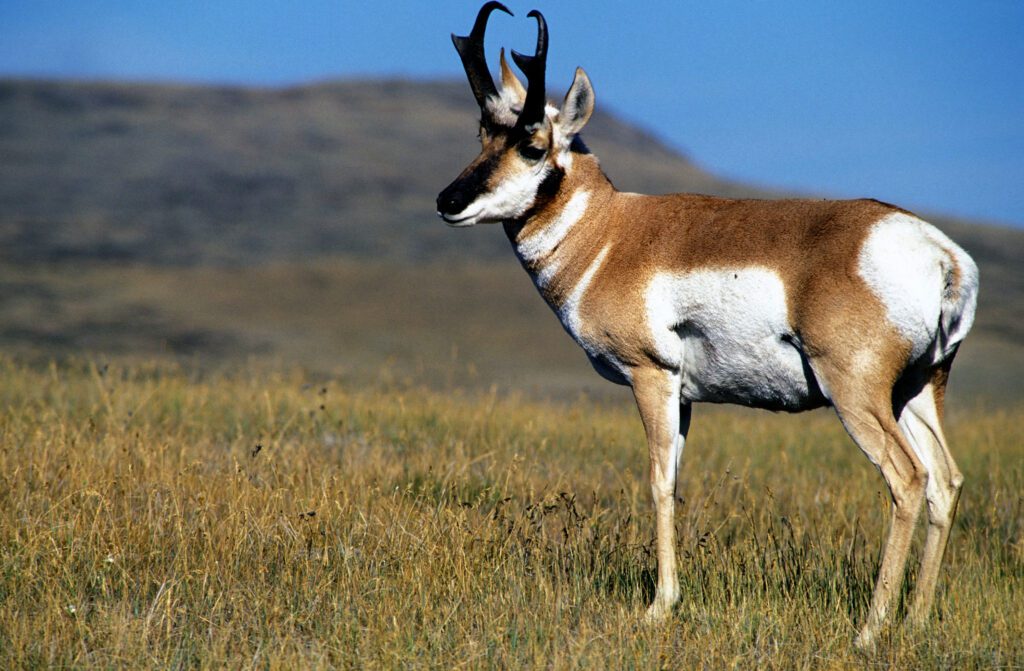
pronghorn
Among the vast array of diverse wildlife, the Pronghorn, or Antilocapra americana, holds a unique position. Often mistaken for a deer, this intriguing creature carries a likeness that easily fools the untrained eye. Yet, beneath this common misperception lies a fascinating truth.
Despite their deer-like physique, pronghorns are the sole surviving members of the Antilocapridae family. Their slender legs, similar in structure to those of deer, and their identical body shape can lead to confusion. However, these remarkable creatures boast a lineage that is more closely related to okapis and giraffes.
Read more: How Fast Can a Cheetah Run? Unveiling the Secrets Behind Its Incredible Speed
Let’s delve into the unique characteristics of the pronghorn that set them apart from deer, and celebrate their unique identity within the animal kingdom.
| Characteristics | Pronghorn | Deer |
|---|---|---|
| Family | Antilocapridae | Cervidae |
| Close Relatives | Okapis, Giraffes | Elk, Moose |
| Body Shape | Similar to Deer | Typical Deer Structure |
| Leg Structure | Similar to Deer | Common Deer Legs |
As you can see, while the Pronghorn may bear a striking resemblance to deer, their roots trace back to a completely different family tree. The next time you spot one, remember, they are not just ‘deer-look-alikes’ but a unique species with their own fascinating story.
2. The Chinkara (Gazella bennettii): The Desert’s Mirage
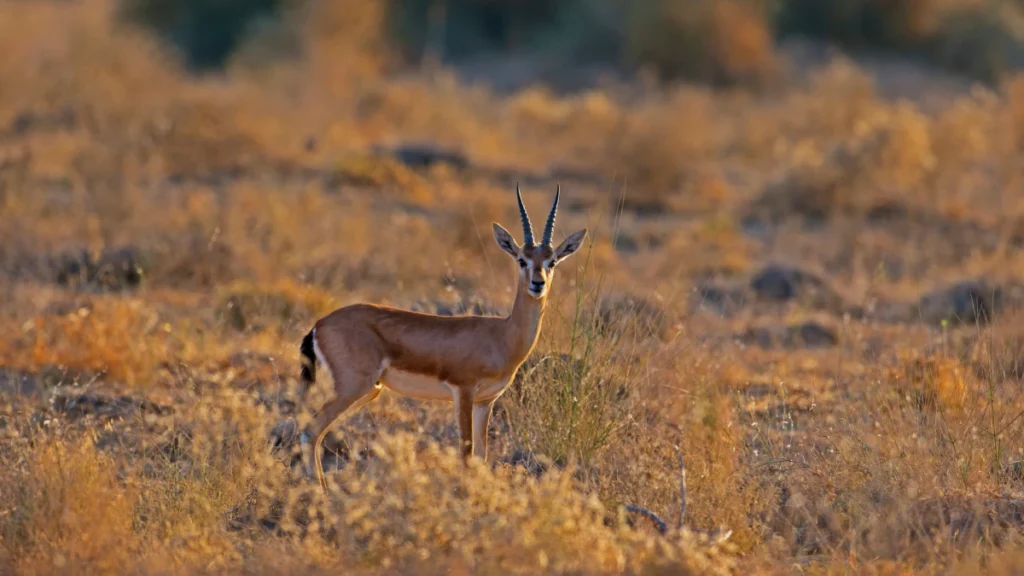
chinkara
Imagine a vast, barren desert landscape stretching as far as the eye can see. The scorching sun beats down on the sparse vegetation, and survival seems barely possible. Yet, amid such daunting conditions, one creature thrives – the Chinkara (Gazella bennettii).
Chinkaras, often mistaken for deer due to their tawny brown coats, are actually a species of gazelle. Their habitat extends across the seemingly inhospitable environments of Iran, India, Pakistan, and Afghanistan. Despite the challenging conditions, these resilient creatures have adapted remarkably well to their surroundings.
What sets these animals apart are their unassuming short horns, a characteristically gazelle trait. But it’s not just their physical appearance that can lead to confusion with deer. Their survival strategy in the harsh desert ecosystem raises many eyebrows.
How do Chinkaras survive in such harsh ecosystems known to experience prolonged water shortages? The answer is as ingenious as it is simple.
Unlike most animals that require a regular water source, Chinkaras have a unique adaptation. They can extract moisture from the dew-laden shrubs they consume. This ability allows them to survive without direct access to water, a key factor in their survival in desert environments.
So, the next time you come across a brown-coated creature in the deserts of Iran, India, Pakistan, or Afghanistan, take a closer look. It might be the resilient and resourceful Chinkara, a true testament to the wonders of adaptation and survival in the animal kingdom.
3. The Majestic Greater Kudu (Tragelaphus strepsiceros)
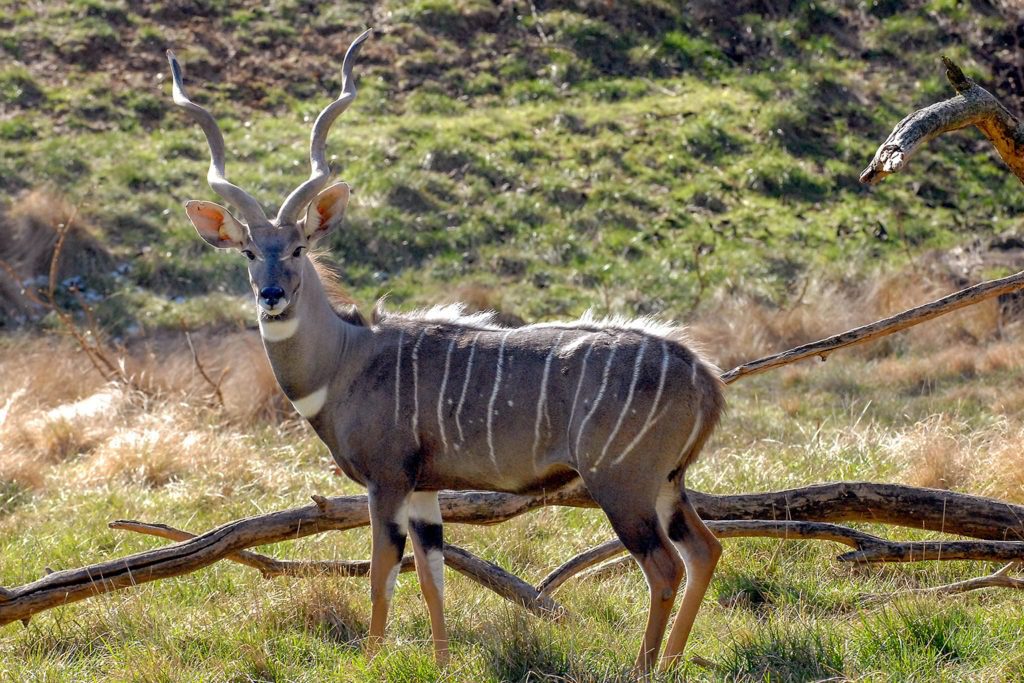
greater kudu
In the vibrant tapestry of wildlife that resembles deer, the greater kudu, an impressive species of large ungulate, holds a unique place. Despite its sleek, thin torso akin to deer, this creature stands out in the animal kingdom due to its stark white stripes and majestic spiraling horns. Imagine a deer with an artistically painted coat and a crown of grandeur, and you are close to visualizing a greater kudu.Belonging to the antelope family, the greater kudu symbolizes an exquisite blend of grace and strength. Its unique features help distinguish it from the deer. The white stripes on its body serve as nature’s own barcode, creating a distinct identity for this magnificent creature.
Native to the lush forests in southern and eastern Africa, the greater kudu is a testament to nature’s creativity and adaptability. With a habitat that ranges from the dense woodlands to the arid savannas, this animal truly embodies the essence of survival and adaptation.
As you delve deeper into the world of the greater kudu, it becomes increasingly clear that while it shares similarities with the deer, it is a unique creature in its own right. The same is true for many other animals, such as the pronghorn and the Chinkara, which showcase the diversity and adaptability of wildlife.
So, the next time you encounter a picture or sighting of the greater kudu, remember to appreciate its individuality and the rich tapestry of life it represents. After all, in the grand scheme of the natural world, every creature has its own tale of evolution and survival to share.
4. Blackbucks: The Graceful Antelopes of the Grasslands
Imagine walking through the lush grasslands of India or Nepal, and spotting a group of animals grazing leisurely. You notice their sleek bodies, their white underbellies, and the spiraling, ringed horns of the males that rise proudly towards the sky. You might mistake them for deer, given their similar habitat and appearance. But in reality, you are witnessing the captivating sight of the Blackbucks, one of the few antelope species native to these regions.
Blackbucks, or Antilope cervicapra, are a sight to behold. Their striking physical features, combined with their agile and swift movements, make them a fascinating subject for nature enthusiasts. Like deer, they prefer habitats near grassy plains and water sources. This is not just a coincidence; it’s a result of their dietary habits and the need for a terrain that provides good visibility to spot predators.
Standing in stark contrast to the arid landscape inhabited by the Chinkara, the habitats of Blackbucks are often characterized by verdant grasslands, interspersed with water bodies. This is a testament to the exceptional adaptability of animals that resemble deer, each finding their niche in vastly different environments. While the Chinkara has learned to extract moisture from the plants it consumes, the Blackbucks flourish near water sources, a trait they share with deer.
While the Chinkara thrives in the desert and the Greater Kudu adorns the African savanna, the Blackbucks paint a vibrant picture against the backdrop of the Indian subcontinent’s grasslands. Each of these animals, though they may look like deer, have their unique stories of survival and adaptation, making our planet’s biodiversity a never-ending source of fascination.
As we move on to explore more animals that bear a striking resemblance to deer, let’s not forget the Blackbucks – a symbol of grace and agility in the heart of India and Nepal’s grasslands.
5. The Majestic Gemsboks
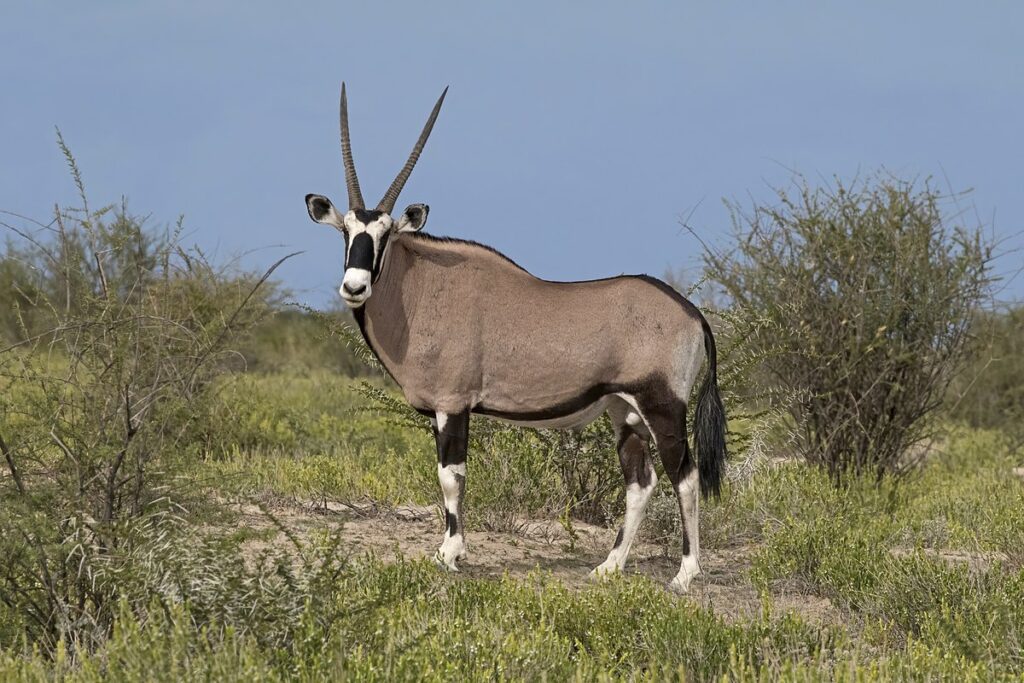
gemsbok
Nestled within the broad spectrum of wildlife that resembles deer, Gemsboks are a testament to nature’s endless capacity for innovation and adaptation. These magnificent creatures, hailing from the Oryx genus of gazelles, are a sight to behold with their imposing stature, akin to a large deer buck.
Unlike their deer-like counterparts who seek the comfort of verdant forests and grasslands, Gemsboks have carved their existence in the harsh, arid expanses of the Kalahari Desert in southern Africa. Their survival in such a tough environment speaks volumes about their resilience and ability to adapt.
One of the most intriguing aspects of the Gemsboks is the distinct difference in their horn structure between males and females. The males sport horns that are shorter and thicker, a stark contrast to the females, whose horns are longer and thinner. This characteristic is a fascinating example of sexual dimorphism in the animal kingdom.
Read more: Which 5 Animals Boast the Most Mesmerizing Purple Eyes? See Their Stunning Pictures!
Fact: Despite belonging to the gazelle family, Gemsboks share a striking resemblance with large deer bucks. Their habitat of choice is the arid Kalahari Desert. The males and females can be told apart by their differing horn structures, with males boasting shorter and thicker horns, while females possess longer and thinner ones.
As we delve deeper into the captivating world of animals resembling deer, the Gemsboks serve as a reminder of the extraordinary diversity that exists within the wildlife kingdom. Their unique survival story in the stark landscapes of southern Africa is a testament to the adaptability and resilience of nature’s creations.
6. The Majestic Roan Antelope
As we journey across the vast landscapes of Africa, we encounter an animal that is strikingly similar to a deer. Meet the Roan Antelope, a creature that emanates beauty, grace, and a certain mystique.
With a reddish-brown coat that seems to be painted by the sun itself, the Roan Antelope stands out in the African wild. It’s as if nature itself took a paintbrush and delicately crafted their colour to match the romantic hues of an African sunset. Adding to this allure are the white spots that speckle their flanks and hindquarters, providing a perfect contrast to their otherwise warm-toned body.
Roan Antelopes, much like deer, feature thick necks and slender legs, creating a silhouette that is both robust and elegant at the same time. But their true showstopper is the pair of spiralling horns that adorn their head, a regal crown that can grow up to an astonishing 4 feet.
Roan Antelopes aren’t just about appearances though. They are also well-adapted to their environment. Much like the Blackbucks we discussed earlier, the Roan Antelope prefers habitats close to water sources. Their ideal home? Open or sparsely forested savannas where the grass grows medium to long, creating the perfect camouflage and feeding ground for these majestic creatures.
So, next time you’re exploring the wilds of Africa, keep an eye out for this magnificent creature. With its deer-like grace and unique characteristics, the Roan Antelope is indeed a sight to behold.
7. Addax – The Chameleon of the Sahara
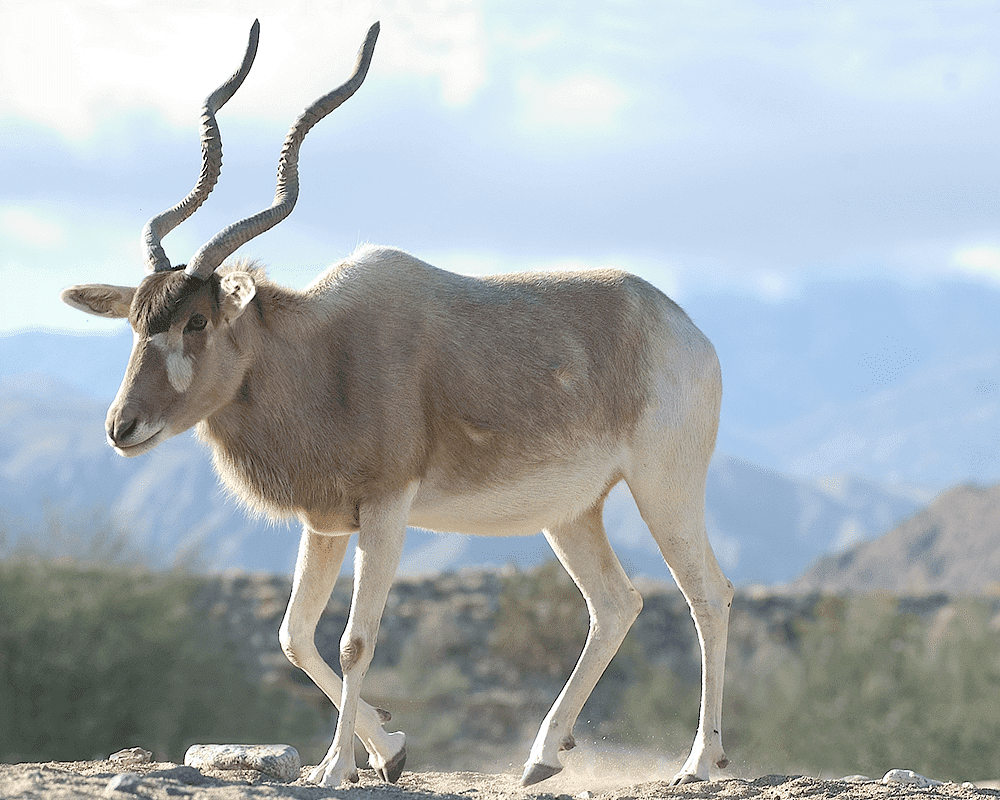
addax
Emerging from the vast, sandy expanse of the Sahara Desert comes our next entrant – the Addax. This fascinating creature, often called the “white antelope,” is far more than just a beautiful sight. It’s a true survivor, an emblem of adaptation, and an unfortunate symbol of the struggle against endangerment.
If you’ve ever wondered about the versatile nature of nature’s creations, the Addax is a prime example. With a survival trick as unique as its striking appearance, it has earned a reputation as the chameleon of the Sahara. The Addax’s coat color, mirroring the changing seasons, shifts from a light, almost white during the scorching summer, to a rich, dark brown in the chillier winter months. This seasonal shift in color not only aids them in managing temperature variations but also provides a natural camouflage, helping them blend into their surroundings as they navigate their harsh desert home.
But why are they often referred to as the “white antelope?” The answer lies in their winter appearance, where their coat lightens to a shade so pale, it resembles the frosty landscapes typically associated with deer. These majestic creatures, braving the desert’s extremes, bear an uncanny resemblance to deer during the winter months, making them a fitting inclusion in our list of beautiful animals that look like deer.
Check out: Which Yellow Birds in California Will Mesmerize You? Discover the Top 9 with Stunning Pics!
The Addax’s story is a compelling testament to nature’s adaptability and resilience. Yet, it serves as a stark reminder of our responsibility to protect these endangered species and the ecosystems they inhabit.
Stay tuned, as our journey continues to unfold the fascinating world of animals that mirror the semblance of deer in their unique ways.
8. Nyala (Tragelaphus angasii): A Deer-Like Dancer of the African Forests
Transitioning from the arid expanse of the Sahara, we journey to the dense forests of Southern and Eastern Africa. Here, amidst the verdant foliage and dappled sunlight, you’ll find the enchanting Nyala (Tragelaphus angasii). With an uncanny resemblance to the familiar deer, the Nyala carries a certain unique charm that sets it apart.
At first glance, the Nyala may appear to be just another deer, but a closer observation reveals its distinctive features. One such noteworthy characteristic is their spiky dorsal crest, a trait which eyes accustomed to deer might find surprising. This crest, akin to the ridged back of a hyena, sets the Nyala apart, making it a fascinating spectacle in the wilderness.
Interestingly, sexual dimorphism is quite pronounced in this species. It’s the females that bear a stronger resemblance to deer, with their slender bodies adorned with thin, white markings running down their flanks. These delicate lines, reminiscent of the dappling on a fawn, add to their deer-like appeal.
Despite these obvious similarities, it’s important to remember that Nyalas are not deer. They are, in fact, antelopes, unique and beautiful in their own right. Nyalas, with their deer-like grace and hyena-like dorsal crests, are indeed one of nature’s most intriguing anomalies.
9. Urial (Ovis vignei): The Mountain Monarch
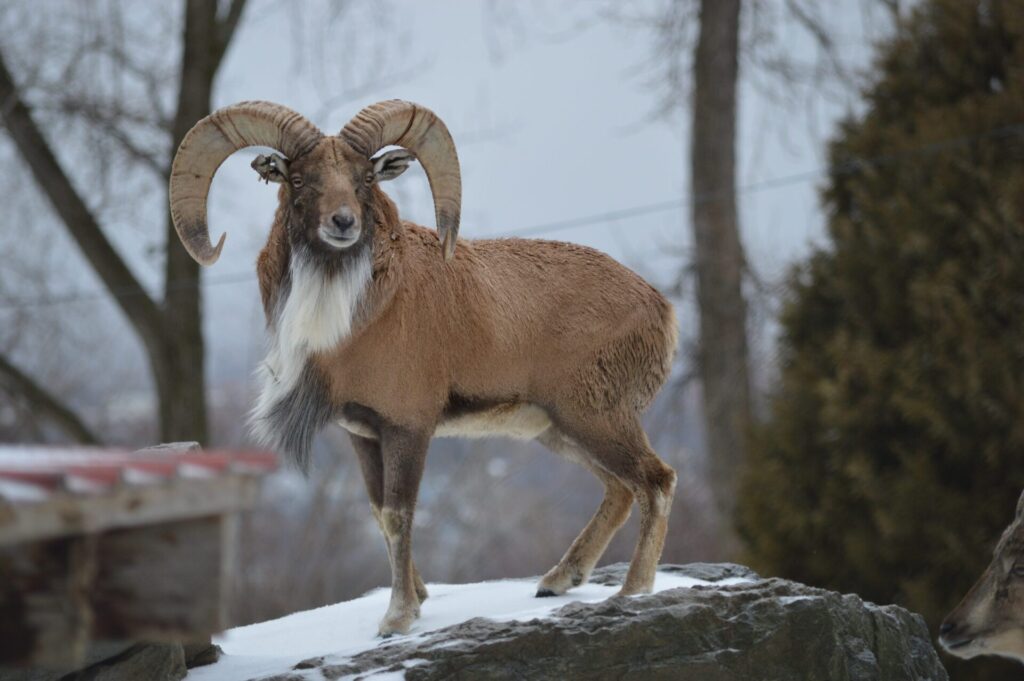
urial
Moving from the plains of Africa to the rugged terrain of the Indian subcontinent, our next splendid creature is the Urial, a wild sheep whose elegant appearance often leads to mistaken identity. With their long legs and massive, spiraling horns, these majestic animals are often mistaken for deer, but a closer look reveals their distinct features.
The Urial, also known as Ovis vignei, stands proud with physical attributes that set them apart from the deer. One of the most pronounced characteristics is their thick “goatee” beards, a striking feature that serves as a telltale sign of their true identity.
At first glance, the Urial might be mistaken for a deer, but upon a closer look, their unique features shine through. Their thick “goatee” beards and massive spiraling horns are the hallmarks of their species.
Another intriguing aspect about the Urial is their choice of habitat. Unlike the deer who prefer lower altitudes and greener pastures, the Urials are lovers of heights. They thrive in the high-altitude habitats of the Indian subcontinent, particularly in the Hindu Kush, Himalayas, and Pamir Mountains. These craggy terrains, with their sparse vegetation and rocky outcrops, provide the perfect backdrop for the Urials’ exceptional agility and adaptability.
So, the next time you’re exploring the highlands of India and spot a creature with long legs, spiraling horns, and a thick beard, remember, it’s not a deer but a Urial, the true monarch of the mountains.
10. Speke’s Gazelle: The Delicate Desert Deer Look-alike
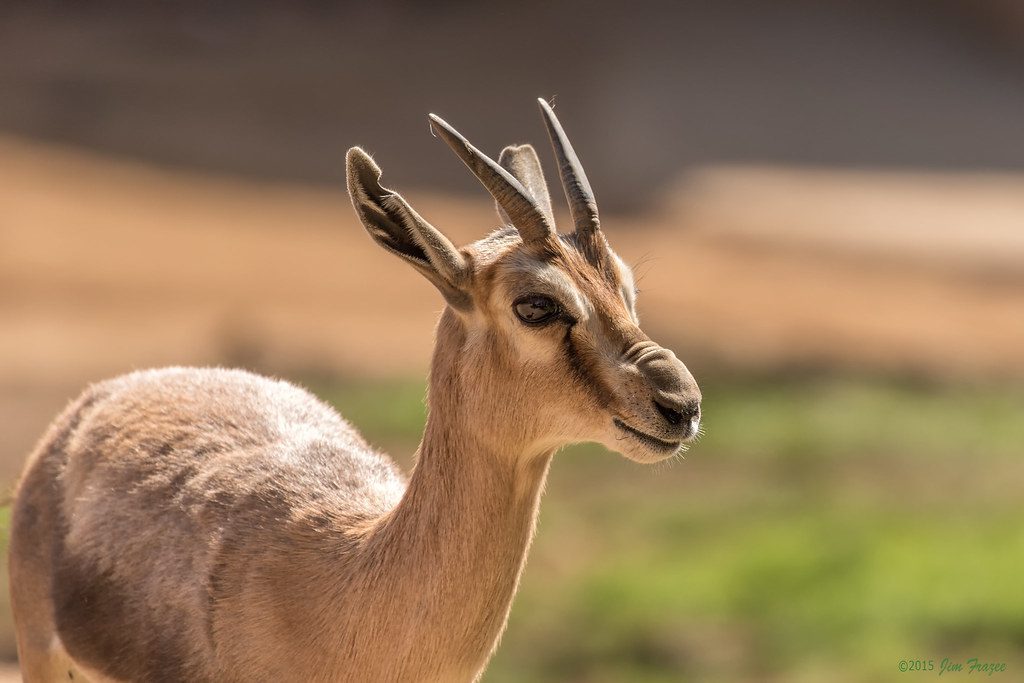
spekes gazelle
As we delve deeper into this intriguing exploration of animals that bear a striking resemblance to deer, we arrive at the enchanting Speke’s Gazelle. This delicate creature, native to the arid expanses of northern Africa, stands as the smallest gazelle species on Earth. It’s easy to mistake this petite gazelle for a young deer fawn, especially given its light, reddish-brown coat that mirrors the gentle hues of a fawn’s fur.
Speke’s Gazelle’s habitat is a stark contrast to the lush forests and high-altitude mountains we’ve traversed with the Nyala and Urial. Its domain is the grass savannas, semi-desert areas, and sandy shrubs of Africa’s northern horn. This resilient gazelle has adapted to thrive in such harsh environments, much like the Gemsbok’s survival in the arid Kalahari Desert.
Did you know? The Speke’s Gazelle is often mistaken for a young deer fawn due to its light reddish-brown coat, a characteristic that makes it a fascinating addition to our list of beautiful animals that look like deer.
However, the survival of this gazelle species is hanging by a thread. The Speke’s Gazelle is currently listed as an endangered species, facing significant threats due to habitat fragmentation and degradation. Efforts are underway to protect and preserve this unique species, with a substantial captive population serving as a beacon of hope for their survival.
As we marvel at the beauty of the Speke’s Gazelle, it’s a poignant reminder of nature’s fragility and the critical importance of conservation efforts. Our journey through the world of deer look-alikes continues, with each creature presenting a unique perspective on nature’s incredible diversity.
11. Chamois Colored Goat: The Deer-Like Domestic Goat
Let’s shift our gaze from the wild terrains of India and Africa to the cultivated landscapes of Europe. Here, we encounter the Chamois Colored Goat, a domestic breed with uncanny semblance to a deer when viewed from afar. Don’t be fooled though, as this creature is a goat through and through, despite its deer-like appearance.
This captivating goat species, with its long, slender neck and earthy brown hue, could easily be mistaken for a deer, especially when it’s grazing peacefully in the fields. Its color, ranging from light beige to a deep, rich brown, mimics the natural shades often seen in deer, adding to its intriguing deception.
But where did this fascinating breed originate? The story of the Chamois Colored Goat dates back to the medieval era. Born amidst the picturesque landscapes of Switzerland, these goats soon found their way to neighboring Austria and Italy, enriching these regions with their presence.
Their journey is a testament to their adaptability and endurance, traits that have allowed them to thrive across different terrains and weather conditions. Their robustness, combined with their remarkable deer-like appearance, makes them a fascinating addition to our list.
So, the next time you’re in Europe and spot what you think is a deer from a distance, take a closer look. It might just be a Chamois Colored Goat, happily grazing away in the pasture, oblivious to its own enchanting deception.
12. The Mighty Miniature: Klipspringer
Among the diverse tapestry of nature’s marvels, there exists an animal that remarkably mirrors the graceful agility of deer, but in a miniature form. Meet the Klipspringer, a petite but power-packed antelope species hailing from the rugged terrains of East and Southern Africa. This small-sized creature, similar to the Speke’s Gazelle and the Chamois Colored Goat, defies the presumption that size determines strength.
Underneath its diminutive stature lies an incredible reservoir of strength, allowing it to navigate through rocky landscapes with ease. Despite being small enough to be mistaken for a young deer fawn, the Klipspringer has carved its niche in the wild, displaying a survival prowess that belies its size.
One of the unique aspects of the Klipspringer’s life is its remarkable monogamous behavior. Unlike many other species, Klipspringers choose one partner for life, demonstrating a degree of loyalty uncommon in the animal kingdom. This extraordinary bond is so strong that adult Klipspringers are seldom found more than 5 meters apart from their partners. This enduring companionship not only highlights the unique social structure of these animals but also adds another layer to their deer-like charm.
Whether it’s their compact build, their incredible strength, or their monogamous behavior, Klipspringers surely deserve a place in the list of animals that bear an uncanny resemblance to deer. They are a testament to the endless diversity and unique adaptations found within the world of wildlife, underscoring the importance of conservation efforts to protect these beautiful creatures and their habitats.
13. Suni: The Miniature Deer-Antelope Hybrid
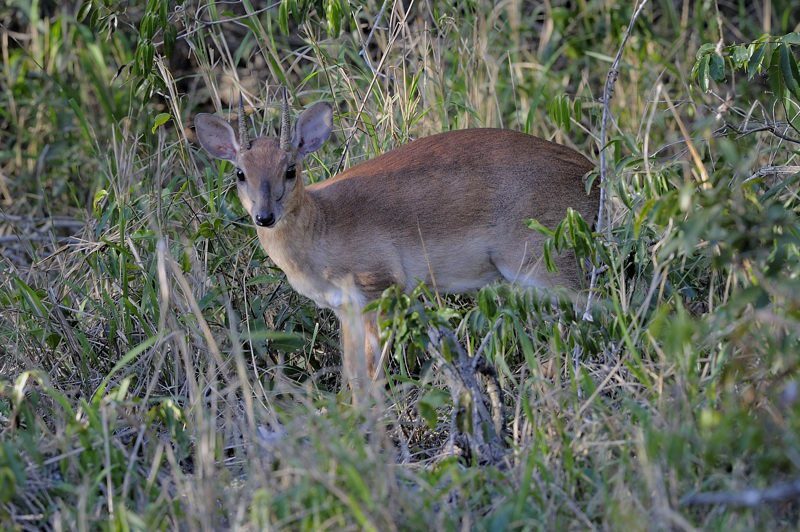
suni
The Suni, a micro-antelope that is often mistaken for a young deer, brings a touch of whimsy to the African landscape. This small creature, standing at only 12 to 17 inches tall, is a perfect example of nature’s knack for creating miniature wonders. The Suni’s charming appearance, with its dark brown upper body contrasting with a white neck and belly, can easily deceive an untrained eye into thinking it has stumbled upon a deer fawn lost in the wild.
Yet, upon closer inspection, one would notice the small, ridged horns curving backward atop the heads of male Suni. These are absent in their female counterparts, adding to their fawn-like innocence. However, these antelopes are more than just their appearances. Their unique barking and whistling calls are a melodious addition to the sounds of the African wilderness, a testament to the diversity in our ecosystem.
Although the Suni’s physical characteristics may lead to a case of mistaken identity, these micro-antelopes stand out in their right. Their size does not define them, but rather, it adds to their charm and uniqueness. So, the next time you spot a Suni, remember, you are witnessing a creature that perfectly embodies the phrase ‘small but mighty’.
Understanding and appreciating these creatures will undoubtedly contribute to ongoing conservation efforts. After all, each species, no matter how small, plays a significant role in maintaining the balance of nature. The Suni, with its deer-like appearance and antelope characteristics, serves as a reminder of the wonderful diversity that exists within wildlife.
14. The Graceful Oribi
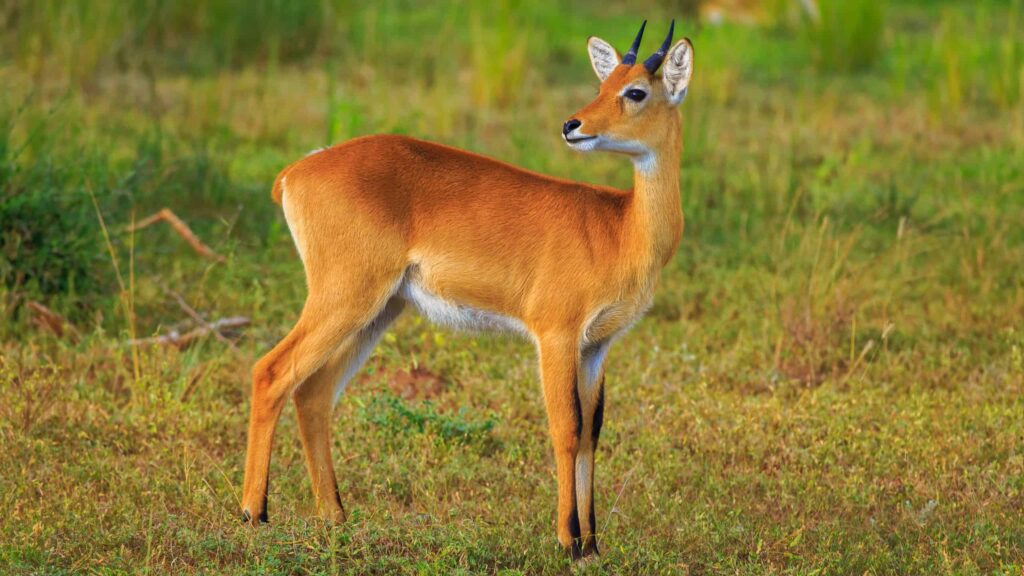
oribi
Let’s continue our exploration of animals that bear a resemblance to deer with our next captivating creature, the Oribi. This enchanting mammal, a member of the antelope family, is clothed in a beautiful red-brown coat that could effortlessly blend into the hues of a late autumn forest. Much like the spotted deer we know and love, the Oribi has a gentle, peaceful aura that captures the heart of anyone lucky enough to encounter it.
Interestingly, the gender of the Oribi plays a significant role in its physical appearance. Mirroring the world of deer, where males are generally larger and more robust, the male Oribi is noticeably larger than its female counterpart. Yet, it is the female Oribi that displays an uncanny resemblance to deer due to her petite size and delicate features. This sexual dimorphism, as it’s scientifically known, makes it even more intriguing for wildlife enthusiasts and observers.
While the Oribi may not be the most famous member of the antelope family, it certainly holds its own in terms of charm and fascination. It thrives throughout the vast landscapes of Africa, gracing every corner of the continent with its presence, save for the northern region. Its adaptability to various environments, from savannahs to semi-deserts, speaks volumes about its resilience and versatility, much like the deer species found across different habitats worldwide.
So, whether you’re traversing the African plains or flipping through the pages of a wildlife magazine, keep an eye out for the Oribi. This stunning creature, with its deer-like elegance, is sure to leave a lasting impression on both your heart and your memory.
15. Impala: The Graceful Mimic of the Deer Family
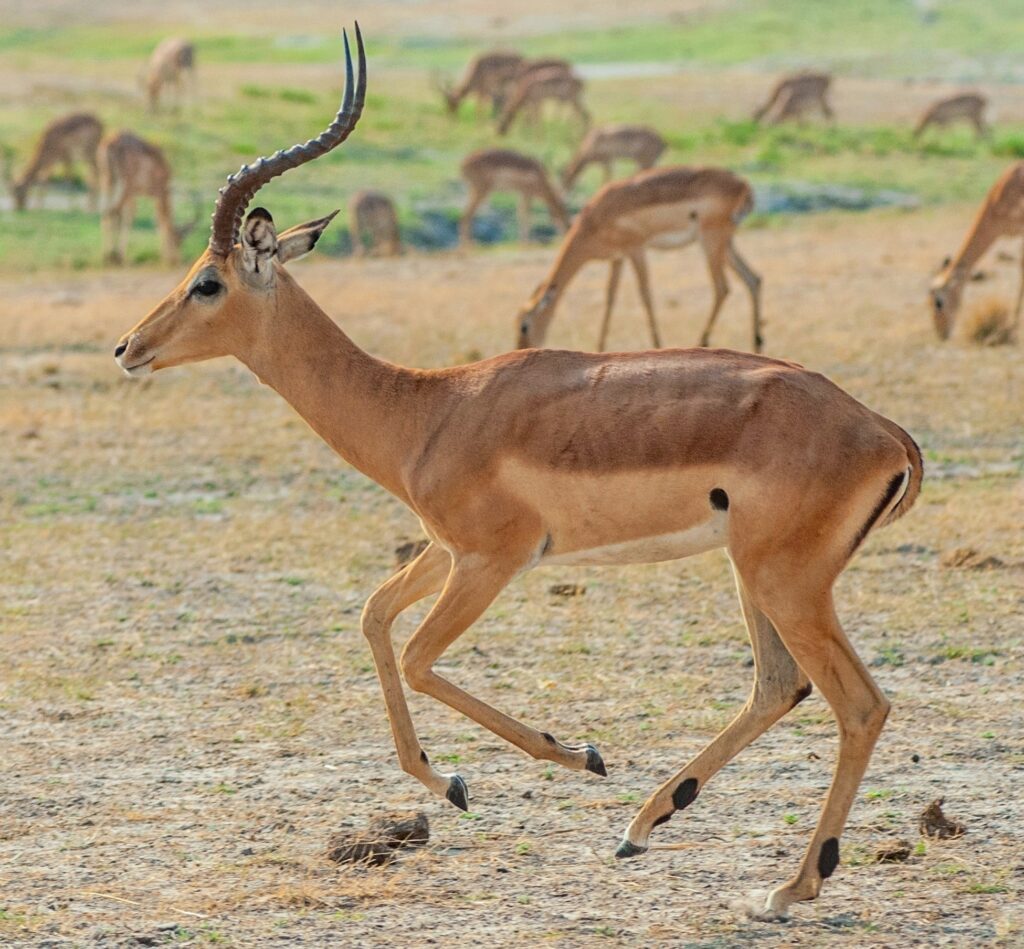
impala
As we journey across the diverse landscapes of Southern and East Africa, we are greeted by the enchanting sight of the Impala. This animal has a compelling resemblance to deer, yet it belongs to the antelope family, adding another layer to the rich tapestry of wildlife that mirrors the elegance of deer.
Standing on slender legs, the Impala carries a body that effortlessly balances power and grace. Their slim frames and light coloration often lead to comparisons with deer, yet a closer look reveals the distinct features that set them apart. The females, or ewes as they are called, maintain a certain doe-like innocence throughout their lives, their sleek and slender bodies moving with a fluidity that is a sight to behold.
The males, on the other hand, grow long, aisles horns that spiral upwards, adding majesty and dignity to their already impressive stature. These horns, a testament to their strength and virility, are a prominent feature that sets them apart from their deer counterparts.
However, the Impala’s resemblance to the deer isn’t just skin deep. Just like the deer, the Impala grazes on a variety of vegetation, its diet including a mix of acacia pods and wild, monocotyledonous plants. This shared dietary pattern further strengthens the connection between the two species.
It’s fascinating to observe how this mimicry of the deer is not an attempt at deception, but rather a beautiful testament to the diversity and adaptability of wildlife. The Impala, in its own unique way, pays homage to its deer-like brethren, while proudly standing as a distinct member of the antelope family.
16. Okapi: A Mesmerizing Blend of the Familiar
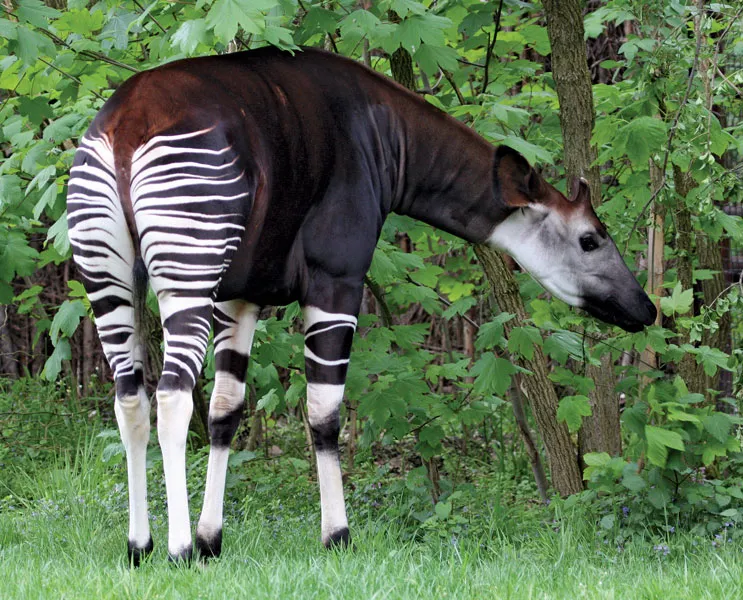
okapi
When you first lay your eyes on an Okapi, you may find yourself captivated by its strange, yet alluring appearance. It’s as if someone has meticulously stitched together fragments of the familiar – a zebra, a deer, and even a hint of a giraffe – to create a creature that is truly unique. However, this isn’t an imaginative chimera from a storybook, but a wondrous testimonial to the enchanting diversity of the animal kingdom.
Adorned with white stripes on its legs that bear an uncanny resemblance to the zebra, the Okapi stands out in the wilderness. These striking markings, set against the backdrop of its lustrous red-brown body fur, give it an air of mystique that leaves observers in awe.
The Okapi, with its zebra-like stripes and deer-like physique, is a living testament to the beauty of nature’s diversity.
Despite its outward resemblance to deer, the Okapi belongs to the Ungulates genus, a group that includes deer and various other large-hoofed animals. Interestingly, the Okapi has a closer kinship to giraffes than to deer. The similarities between these species are not immediately apparent, given their contrasting heights and body structures. However, the Okapi’s long, prehensile tongue, used to strip leaves from trees just like giraffes, is a subtle hint of their shared lineage.
As we delve into the captivating world of animals that look like deer, the Okapi serves as a powerful reminder of the boundless variety in nature. It demonstrates that even within a specific category, like ungulates, there’s a breathtaking range of forms and adaptations.
So, let’s continue our journey, getting to know more about these fascinating creatures, and appreciating the myriad ways in which they echo the deer’s charm, while also revealing their own unique beauty.
17. Springbok
Moving away from the rainforests of the Okapi, our exploration brings us to the arid landscapes of south and southwest Africa. Here we encounter the Springbok, another fascinating creature that beautifully mirrors the charm of deer. This medium-sized antelope is a sight to behold, with its delicate stature, gentle eyes, and a coat that mirrors the soft hues of a deer’s hide.
However, the Springbok sets itself apart with a set of distinct features. Take a look at its ears; they’re large, diamond-shaped, and add an intriguing appeal to their visage. And if that doesn’t capture your attention, their inwardly curved horns will. These horns, while not as spiraling as an Impala’s, are a captivating sight on the open plains of Africa.
Another characteristic that distinguishes the Springbok from its deer counterparts is a dark stripe running from the corner of its mouth to its eye. It’s as if nature painted an elegant stroke of mascara, amplifying their alluring gaze.
The Springbok, like its fellow deer look-alike animals, showcases the tapestry of diversity and adaptability in the kingdom of wildlife. It pays homage to the elegance of deer, yet stands distinctly in its unique charm, reminding us that beauty comes in many forms.
As we bask in the allure of the Springbok, let’s take a moment to appreciate the natural artistry that has given us these splendid creatures, each a tribute to the grace and majesty of the deer. Stay tuned, as our journey into the world of deer-like animals continues to unfold surprises.
18. The Enchanting Mouse Deer (Chevrotain)
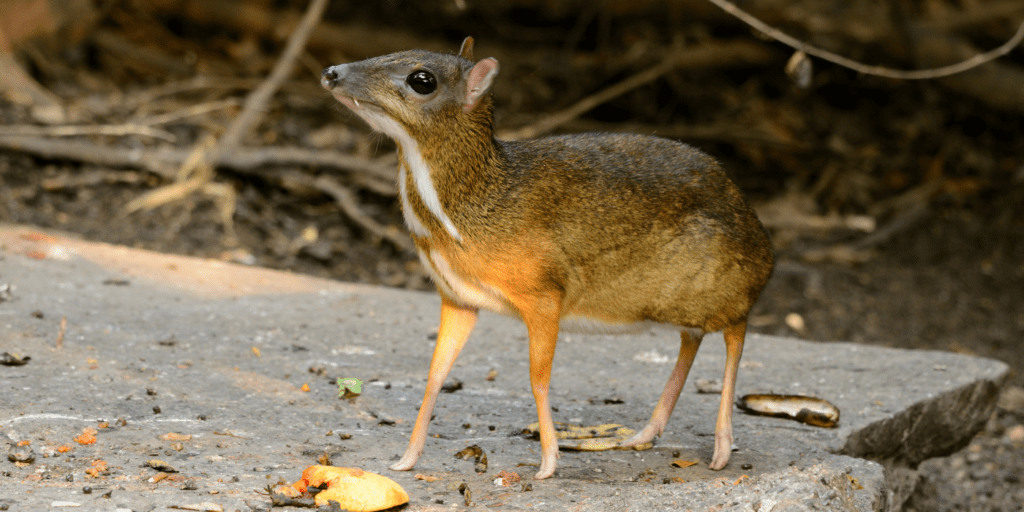
mouse-deer
Imagine wandering through the dense jungles of Asia, where the air is heavy with moisture and the chittering of birds and insects fills your ears. Suddenly, you notice a tiny creature peeping out from the undergrowth. At first glance, you might mistake it for a young deer fawn, given its delicate features and a light red-brown coat, akin to the soft hues of a setting sun. However, this creature is neither a mouse nor a deer. Allow me to introduce you to the enchanting Mouse Deer, or Chevrotain.
Remember the Okapi and Springbok from our previous sections, which showcased the mesmerizing diversity of deer-like animals? The Mouse Deer, or Chevrotain, continues this captivating narrative. Despite its deer-like appearance, the Mouse Deer is unique in its own right, boasting the title of being the smallest ungulate, or hoofed mammal, in the world.
“The Mouse Deer’s unique characteristics embody the remarkable diversity and adaptability of animals that resemble deer, yet stand out with their unique charm.”
Belonging to the family Tragulidae, these tiny hoofed creatures are endemic to the southern and southeast regions of Asia, where they call the deep, lush jungles home. Known for their timid nature, Mouse Deer prefer the solitude of the forest, where their reddish-brown coat blends seamlessly with the earthy tones of the jungle floor, providing the perfect camouflage.
So, the next time you venture into the wild and spot a creature that seems to be a blend between a mouse and a young deer, remember the enchanting Mouse Deer. The animal kingdom is filled with wonders, and the Mouse Deer is certainly one of them, paying tribute to the elegance of deer while possessing its own unique charm.
Yes, pronghorn and deer share physical characteristics like body shape and leg structure.
Yes, pronghorn are often mistaken for deer due to their similarities in appearance.
No, pronghorn are not related to deer. They belong to the Antilocapridae family, while deer belong to the Cervidae family.
Yes, there are several animals that resemble deer, such as chinkara, greater kudu, blackbucks, gemsboks, roan antelope, addax, nyala, urial, Speke’s gazelle, chamois colored goat, klipspringer, suni, oribi, impala, okapi, springbok, and mouse deer (chevrotain).

